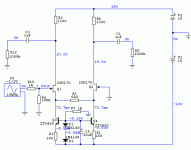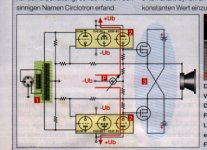Hi EUVL,
Singapore not far geographically but its still another country and for me buying 4 pcs 2 SJ74 from different countries is a nightmare.
I have order a magazine from Germany and receive it 6 month later becaouse its send to Philippines, yes the post problem can happend in domestic also but its easier to track to me.
May be not a same field but its my last experience.
thanks
Singapore not far geographically but its still another country and for me buying 4 pcs 2 SJ74 from different countries is a nightmare.
I have order a magazine from Germany and receive it 6 month later becaouse its send to Philippines, yes the post problem can happend in domestic also but its easier to track to me.
May be not a same field but its my last experience.
thanks
Hi Mike,
I pulled from storage what I thought would be ideal transformers. I had labelled them 18V but it turns out they are 0-9 and 0-9. Can I make a low powered version of the Circlotron and can you give me an idea of any changes in component values?
thanks, sp
I pulled from storage what I thought would be ideal transformers. I had labelled them 18V but it turns out they are 0-9 and 0-9. Can I make a low powered version of the Circlotron and can you give me an idea of any changes in component values?
thanks, sp
There are one or two dealers in your country. Please check the trading post or group buy threads.
Patrick
Patrick
Rembulan, I wouldn't recommend buying exactly the number of fets you need, they can become damaged, burned out, or behave quite differently to another one supposedly the same. Pass Diy had an article on mosfet matching I think, I'll try to implement it too, it's so you get to select fets that are similar enough to operate happily together with lower distortion, here it is: http://www.passdiy.com/pdf/mos.pdf
So is the smallest number you can get locally still affordable? If you match pairs or quads within them you could get good results, have have some left over to sell when the world runs out of them, not that I ever though that was imminent.
So is the smallest number you can get locally still affordable? If you match pairs or quads within them you could get good results, have have some left over to sell when the world runs out of them, not that I ever though that was imminent.
Rembulan, I wouldn't recommend buying exactly the number of fets you need, they can become damaged, burned out, or behave quite differently to another one supposedly the same. Pass Diy had an article on mosfet matching I think, I'll try to implement it too, it's so you get to select fets that are similar enough to operate happily together with lower distortion, here it is: http://www.passdiy.com/pdf/mos.pdf
So is the smallest number you can get locally still affordable? If you match pairs or quads within them you could get good results, have have some left over to sell when the world runs out of them, not that I ever though that was imminent.
Hi Pikefish,
How can I look for more than 4 to match even 4 pcs is not available...............................locallly I mean
So is the smallest number you can get locally still affordable? If you match pairs or quads within them you could get good results, have have some left over to sell when the world runs out of them, not that I ever though that was imminent.
Hi Pikefish,
How can I look for more than 4 to match even 4 pcs is not available...............................locallly I mean
Ah sorry, I misunderstood you. You can't even buy just 4, I thought you could only buy like 100 packs or something.
Here is another SingleEnded to Balanced signal converting circuit. It sounds better to me than one published in post #69. I used JFETs with Idss=7.5 mA and each CCS gives 6.5 mA (depending on diodes used R1 and R5 might need adjusting: lower R => higher I). R2 sets the gain: lower R => higher gain. With R2=680 R I have 1.5 V/V and with R2=510 R I have 2V/V=6dB gain. Matching JFETs is important.
It easily drives Mike's circlotron with Zin=100k and sounds really good. I even tried to load it with 10K pot and it still sounded the same, there was only 10% drop in signal amplitude.
It easily drives Mike's circlotron with Zin=100k and sounds really good. I even tried to load it with 10K pot and it still sounded the same, there was only 10% drop in signal amplitude.
Attachments
Is there any disadvantage to using a transformer to create balanced signal?
I'm guessing they're just 3 windings with the same number of turns each, and you use the secondary windings out of phase, am I right? I was thinking of winding my own toroidal ones.
I'm guessing they're just 3 windings with the same number of turns each, and you use the secondary windings out of phase, am I right? I was thinking of winding my own toroidal ones.
Pikefish said:Is there any disadvantage to using a transformer to create balanced signal?
It's mainly a matter of personal preference - some people like the sound of transformers, some don't. You'll know when you give it a try. Another thing - good audio transformers don't come cheap.
Pikefish said:
I'm guessing they're just 3 windings with the same number of turns each, and you use the secondary windings out of phase, am I right? I was thinking of winding my own toroidal ones.
Basically yes, that's it. But not only that - Steve Edy and other transformer loving guys might want to explain it in more detail - the core, windings, wire...
stoolpigeon said:Hi Mike,
I pulled from storage what I thought would be ideal transformers. I had labelled them 18V but it turns out they are 0-9 and 0-9. Can I make a low powered version of the Circlotron and can you give me an idea of any changes in component values?
thanks, sp
If you like, I could fire mine up on a Variac and see what happens, but that sounds awfully low and I think the distortion will be several times greater.
Hi Mike,
I would appreciate that.
I have some efficient speakers so low power is fine. I am also used to an original Zen which I think has much higher distortion anyway.
thanks, sp
I would appreciate that.
I have some efficient speakers so low power is fine. I am also used to an original Zen which I think has much higher distortion anyway.
thanks, sp
sp:
With 12V rails I saw .03% THD at one Watt hitting 1% at around seven Watts. That's keeping the 1.2A bias and no circuit changes.
I leave it for you to decide if that's okay.
With 12V rails I saw .03% THD at one Watt hitting 1% at around seven Watts. That's keeping the 1.2A bias and no circuit changes.
I leave it for you to decide if that's okay.
Hello
It is possible to use 2SK1529 power mosfet instead IRFP240.
EUVL U are familiar with these Toshiba mosfet would you please let me know .
If I have to change some resistor values please let me know .
Thank you very much .
Greets .
It is possible to use 2SK1529 power mosfet instead IRFP240.
EUVL U are familiar with these Toshiba mosfet would you please let me know .
If I have to change some resistor values please let me know .
Thank you very much .
Greets .
Thought I might mention that if the original photo posted is not fan cooled, then the heatsink is apparently rotated 90 degrees from its proper position for natural convection operation...
Also, the bottom of a heatsink used for natural convection needs to have an unimpeded source of air - usually a volume equal or greater than the open area of the heatsink (on the bottom) in order to not create a resistance that reduces the convection...
and an equally free route out the top.
For most class AB amps it doesn't matter usually because the heat load is usually lower and if highish usually transitory. Class A is constant heat (of course).
_-_-bear
Also, the bottom of a heatsink used for natural convection needs to have an unimpeded source of air - usually a volume equal or greater than the open area of the heatsink (on the bottom) in order to not create a resistance that reduces the convection...
and an equally free route out the top.
For most class AB amps it doesn't matter usually because the heat load is usually lower and if highish usually transitory. Class A is constant heat (of course).
_-_-bear
You can use 2SK1529Y but you might find that the trimpot to bias the Vgs of the MOSFET has to be lower in value. Perhaps you trim it first and then consider replacing it with a fixed resistor afterwards. 2SK1529 has about 1.5V less Vgs than IRF at the same current.
As to the Thorens schematics, you'll find out more about his "invention" than this HiFi magazine schematics. He did not invent the circlotron circuit he used, just the bias stabilisation, which is essentially a common-mode servo plus a differential servo.
Amazing what people can patent these days, including method to identify certain genes of a pig !!!
Patrick
As to the Thorens schematics, you'll find out more about his "invention" than this HiFi magazine schematics. He did not invent the circlotron circuit he used, just the bias stabilisation, which is essentially a common-mode servo plus a differential servo.
Amazing what people can patent these days, including method to identify certain genes of a pig !!!
Patrick
Patrick (EUVL) perhaps, you are the only one other than Nelson who can comment about the sound of the Circlotron vs F5 at the time, having built both; would you like to go ahead.
Thanks.
Thanks.
I've listened to the F5 very briefly, but not side-by-side with the Circlotron. I suspect they're very similar. One day I'll build an F5 and make a real comparison, but alas, I haven't been able to do much hobby-wise lately.
- Home
- Amplifiers
- Pass Labs
- The Amazing Fet Circlotron by Mike Rothacher

